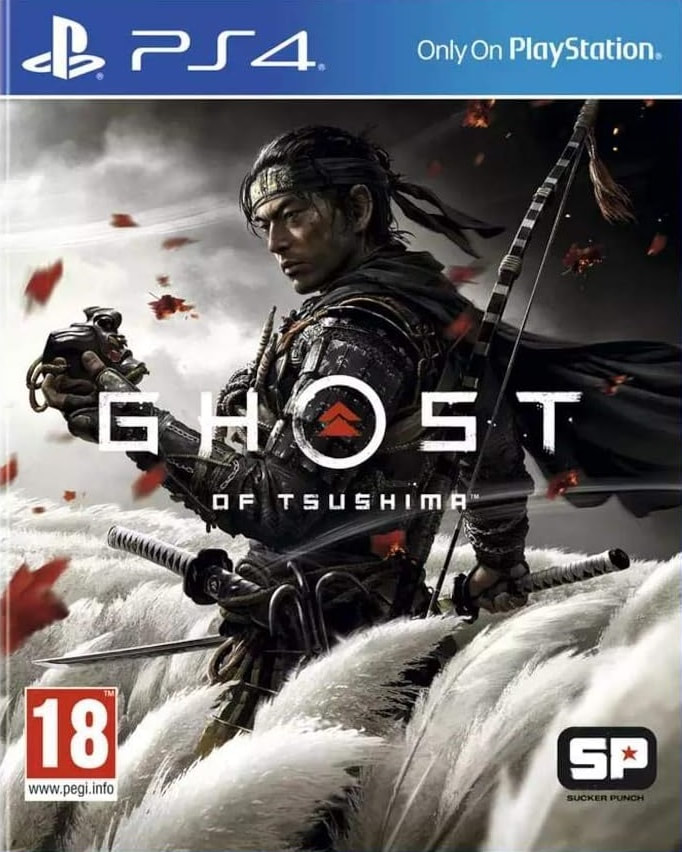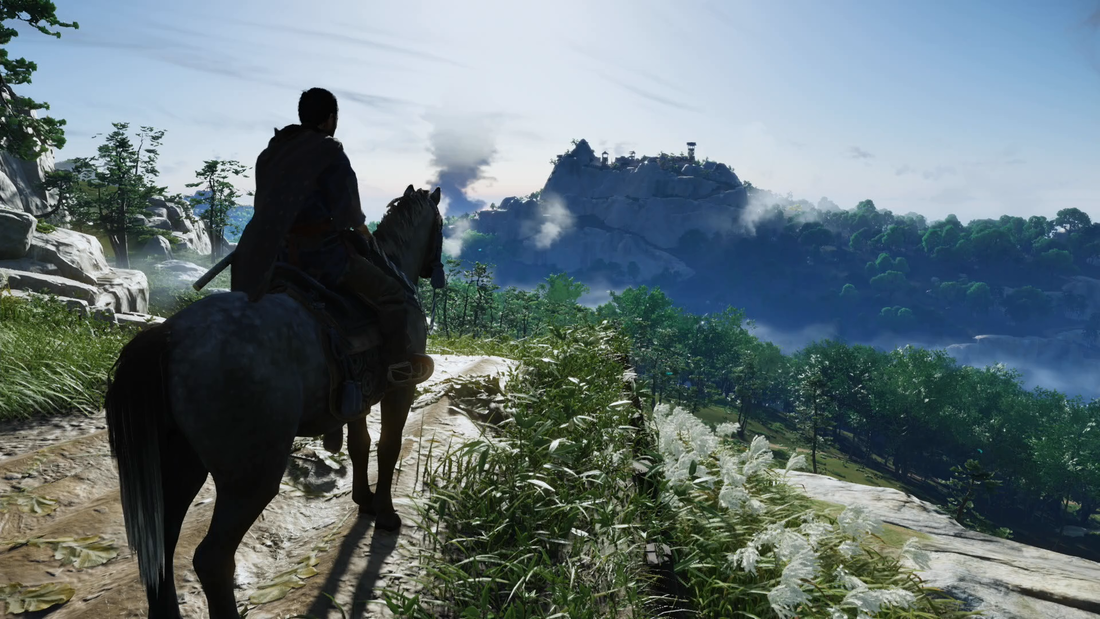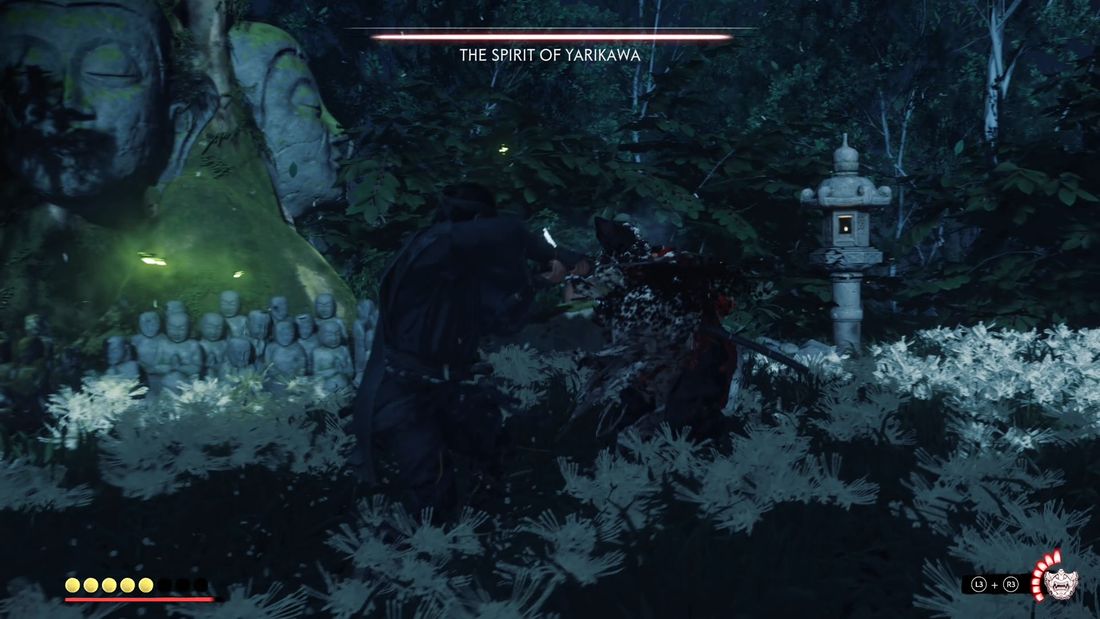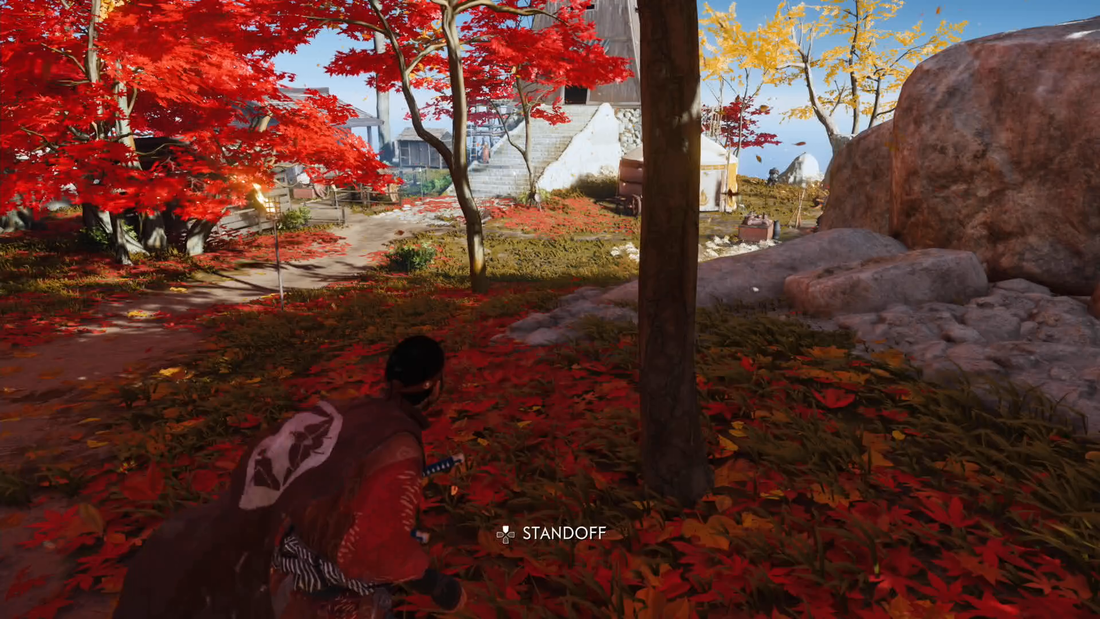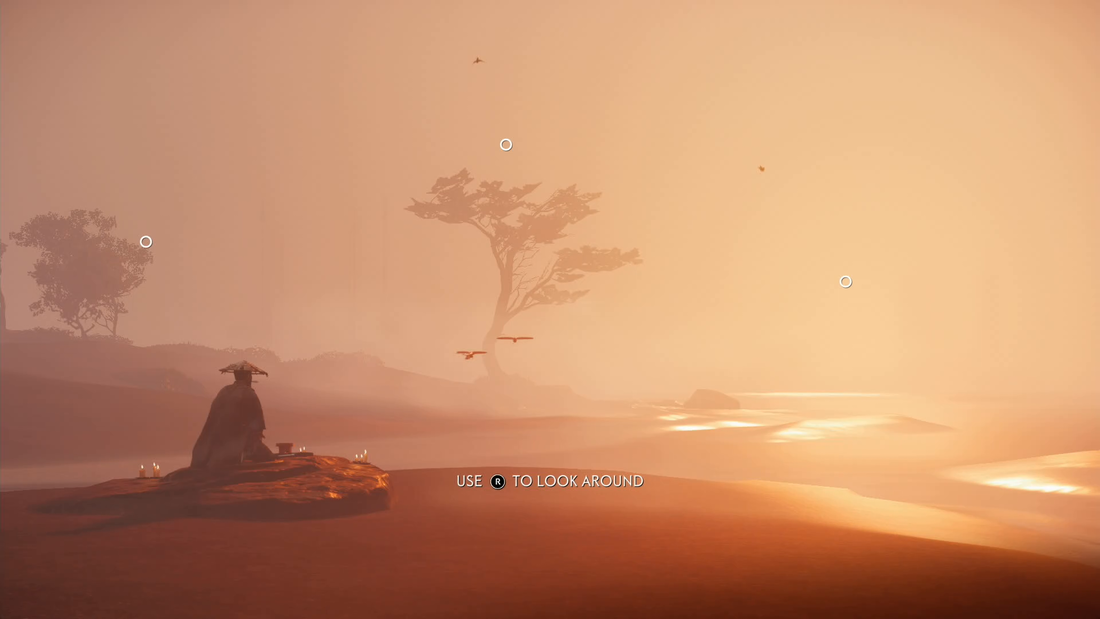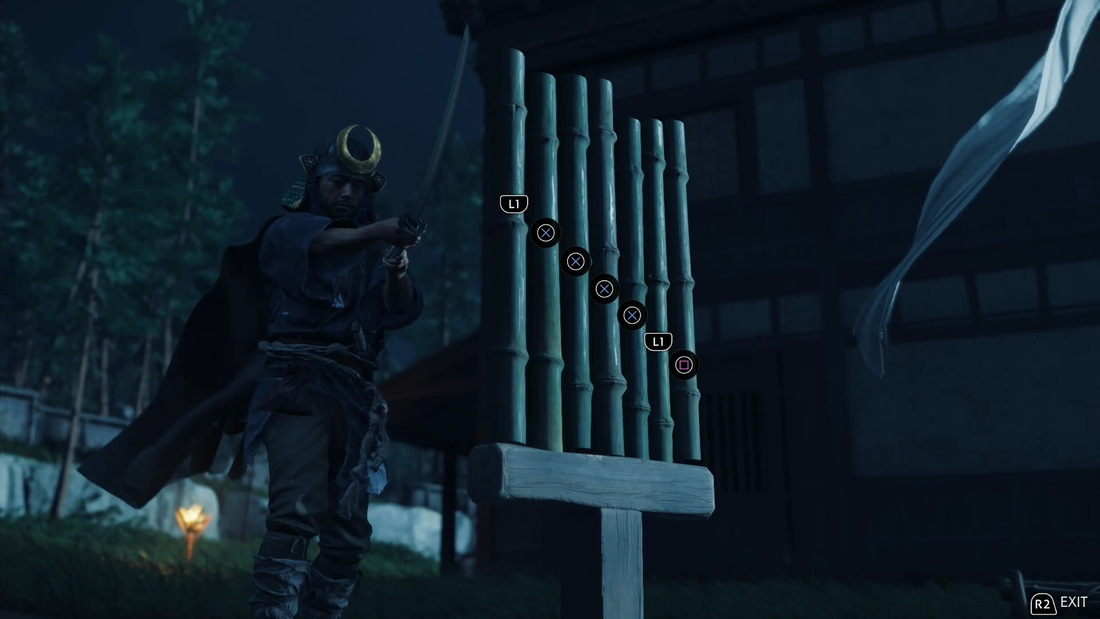GHOST OF TSUSHIMA (PS4)
After proving a dependable first-party developer with titles such as Sly Raccoon and inFAMOUS, Sucker Punch would spend the better part of six years crafting their PlayStation 4 magnum opus: Ghost of Tsushima. A samurai epic inspired by the works of Kurosawa and faced with the unenviable task of matching up to some seriously tough competition (even amongst the PS4’s own pool of exclusives) Sucker Punch managed to deliver to a supremely high standard. A moving story, stunning world, sharp combat and immense range of activities culminate in a superb game, and while some minor blights mean it doesn’t quite reach the summit of open-world gaming, it’s still an absolute must for PS4 owners.
Set in Feudal Japan, a period with surprisingly sparse representation in gaming, Jin Sakai is the samurai hero of the piece. When Mongolians invade, led by the fierce Khotun Khan, Jin and his fellow samurai prepare to defend the land. However, the battle ends in disaster with nearly all the warriors killed, Jin’s uncle captured and Sakai left for dead, only barely surviving thanks to treatment by a thief named Yuna. As Mongolians take over the entire island, it is up to Jin and the warriors he recruits along the way to repel the forces. It sounds like a predictable tale, but the interesting core comes from the Samurai Code, which Jin begins to break to try and overcome the overwhelming oppression of Khan. A majority of the cast is extremely likeable, with Jin proving a compelling hero who grows into the hero of the land. A smartly-written narrative leaves you wondering whether the personal cost is too great, providing a huge layer of tension. With a remarkably mature script, excellent voice work and incredible motion capture, the story is told beautifully.
It's beautiful landscapes everywhere you look in Tsushima, one of gaming's prettiest environments
The first thing you’ll notice is how incredible Ghost of Tsushima looks. The huge open world is rife with details, be it falling leaves, waving crops in the wind and stunning lighting which cloaks the land in light, dark or sun depending on the time of day. Unique settlements are dotted around, with their own intricate décor and roaming NPCs. Animations are fluid, whether during cut-scenes, combat or riding horseback. It’s a beauty, so much so that the photo mode will get incredible use. But the audio doesn’t slouch either. The music, a rich accompaniment including orchestral, oriental and epic themes adds weight to every moment and emotion. The sharp sounds of combat, whistling wind and ear-ringing explosions hit the mark. As mentioned, the voice work is impeccable, while also allowing for a more faithful Japanese track. You can even add a Kurosawa filter, which colours the screen with a weathered black-and-white filter and scratchy audio, for maximum authenticity.
But Ghost of Tsushima is not just a presentation powerhouse, with compelling gameplay to boot. On the technical side of things, it’s mostly positive news. Combat is smooth and responsive, with a focus on timed parries and dodges which let you perform a devastating attack. Enemies require differing tactics, as larger foes and shield-wielders prove harder to put down than archers. But Jin’s four styles of swordsmanship, learned by increasing his level, are more efficient against different types of Mongols, requiring constant management to ace. Stealth is great too, with clear lines-of-sight and a slew of techniques allowing you great satisfaction as you snuff out an outpost without making a sound. Even smaller elements, such as horse-riding and platforming, control well. There are only a couple of notiable downsides. The camera during combat is, to be frank, inconsistent. Sometimes getting stuck on objects, obscuring your view or meandering to catch up, it can prove hard to control. Inevitably, some missions where stealth is mandatory prove frustrating, though frequent checkpoints ease that burden. For the most part, however, Ghost of Tsushima is a hell of a lot of fun.
But Ghost of Tsushima is not just a presentation powerhouse, with compelling gameplay to boot. On the technical side of things, it’s mostly positive news. Combat is smooth and responsive, with a focus on timed parries and dodges which let you perform a devastating attack. Enemies require differing tactics, as larger foes and shield-wielders prove harder to put down than archers. But Jin’s four styles of swordsmanship, learned by increasing his level, are more efficient against different types of Mongols, requiring constant management to ace. Stealth is great too, with clear lines-of-sight and a slew of techniques allowing you great satisfaction as you snuff out an outpost without making a sound. Even smaller elements, such as horse-riding and platforming, control well. There are only a couple of notiable downsides. The camera during combat is, to be frank, inconsistent. Sometimes getting stuck on objects, obscuring your view or meandering to catch up, it can prove hard to control. Inevitably, some missions where stealth is mandatory prove frustrating, though frequent checkpoints ease that burden. For the most part, however, Ghost of Tsushima is a hell of a lot of fun.
FOCAL POINT: WAY OF THE SAMURAI
While there’s only been a small number of samurai games, Ghost of Tsushima is among the strongest. This is best demonstrated in Duels, notable one-versus-one fights that play like a scene out of Harakiri. A real test of your blocking and parrying abilities, these epic fights demonstrate Sucker Punch’s love for Kurosawa, whether it’s the brief stops for the participants to taunt each other, the brutal blood splatter which forms further into battle and the often-dramatic finishes that leave you breathless. It highlights how beautifully combat flows, and without the camera woes which plague regular combat, these encounters are wonderful. Other cool touches, such as challenging unaware groups of foes to a stand-off, with quick reactions required to strike first, make this some serious Samurai wish fulfilment. If you’ve ever dreamt of becoming a Samurai, this is the game for you.
Along with traditional, albeit exciting, story missions, there’s a plethora of side activities throughout the three locations. Fully fledged side missions prove a highlight, offering an insight into the lives of peasants you meet along the way and some feature very haunting outcomes. Mongol bases are another huge component, allowing you to either take a stealthy or combat approach and small bonus objectives offer incentive for experimentation. There are also a ton of collectable activities, which admittedly vary in quality, such as basic Fox Den chases, climbing Lighthouses and reigniting them and Baths that increase Jin’s health. Everything you do increases his reputation, allowing you to unlock a slew of skills including multi-stealth kills, leaping strikes from horseback and Ghost Weapons such as smoke bombs, darts and a plethora of bow types. Growing into the legend is a joy and although not every activity is a winner, they’re still rewarding to complete, and seeing everything will likely take close to 50 hours.
A myriad of activities help to keep Jin's journeying interesting
Ghost of Tsushima is a fantastic game, perhaps Sucker Punch’s best effort to date and a wonderful swansong for the PS4. A beautiful, bloody and compelling journey, it blows competing samurai games out of the water. The story is immensely compelling, the world is a stunning recreation of Feudal Japan, the range of mechanical elements almost all work superbly and the sandbox trimmings come across positively for the most part. Despite some camera foibles and a couple of less compelling side activities, it proves a standout in a very crowded genre. Make no mistake: if you own a PS4, then this one should be in your collection without fail.
|
|
VERDICT
"A wonderful swansong for the PS4, Ghost of Tsushima proves a beautiful, bloody and compelling game, blowing competing samurai games out of the water." OVERALL: 9/10 |
PIXEL SECONDS: GHOST OF TSUSHIMA (PS4)
Ghost of Tsushima proves a standout based on the strength of its themes, highlighting gaming’s progression in terms of the maturity of its storytelling and the beauty of its art style. Games featuring a samurai lead are unusual enough and GoT successfully builds an evocative, gorgeously-realised vision of feudal Japan around Assassin’s Creed-inspired gameplay. There’s as much stealth as there is swordplay, lending the game an odd yet fluid dynamic as the action dances between ninja-like guile from the shadows and samurai open combat. This duality is explored with intelligence and poise throughout a gripping story that sees Jin torn between a sense of honour and the need to fight the invading Mongol army with effective but unethical tactics. His cohorts are no less fascinating: Yuna, a thief who saves the protagonist’s life at the beginning, is an immense presence. Bowman Ishikawa, clan leader Lady Adachi and fighting monk Norio all see their beliefs tested in remarkable arcs that see the brutalities of war and betrayal alter the player’s perception towards initially uncomplicated-sounding missions. A few wandering camera issues aside, the combat is first-class, especially during the sparkling duels and stand-offs, where quick reactions mix with solid mechanics for an absorbing, exciting experience. The game looks and sounds fantastic, whilst a majority of its secondary missions (and in particular, the mystic tales) hit the mark. There are perhaps a few too many collectables, meaning otherwise novel ideas such as following foxes to hidden shrines, composing haikus and sampling hot springs lose a sense of novelty due to their sheer frequency. Sucker Punch’s effort is nevertheless a superb open-world title, with Tsushima proving one of the most striking locations you’ll have the pleasure of exploring. [9] – Tom Clare © 2023
Ghost of Tsushima proves a standout based on the strength of its themes, highlighting gaming’s progression in terms of the maturity of its storytelling and the beauty of its art style. Games featuring a samurai lead are unusual enough and GoT successfully builds an evocative, gorgeously-realised vision of feudal Japan around Assassin’s Creed-inspired gameplay. There’s as much stealth as there is swordplay, lending the game an odd yet fluid dynamic as the action dances between ninja-like guile from the shadows and samurai open combat. This duality is explored with intelligence and poise throughout a gripping story that sees Jin torn between a sense of honour and the need to fight the invading Mongol army with effective but unethical tactics. His cohorts are no less fascinating: Yuna, a thief who saves the protagonist’s life at the beginning, is an immense presence. Bowman Ishikawa, clan leader Lady Adachi and fighting monk Norio all see their beliefs tested in remarkable arcs that see the brutalities of war and betrayal alter the player’s perception towards initially uncomplicated-sounding missions. A few wandering camera issues aside, the combat is first-class, especially during the sparkling duels and stand-offs, where quick reactions mix with solid mechanics for an absorbing, exciting experience. The game looks and sounds fantastic, whilst a majority of its secondary missions (and in particular, the mystic tales) hit the mark. There are perhaps a few too many collectables, meaning otherwise novel ideas such as following foxes to hidden shrines, composing haikus and sampling hot springs lose a sense of novelty due to their sheer frequency. Sucker Punch’s effort is nevertheless a superb open-world title, with Tsushima proving one of the most striking locations you’ll have the pleasure of exploring. [9] – Tom Clare © 2023
OTHER GAMES SET IN JAPAN FEATURING SWORDPLAY REVIEWED
